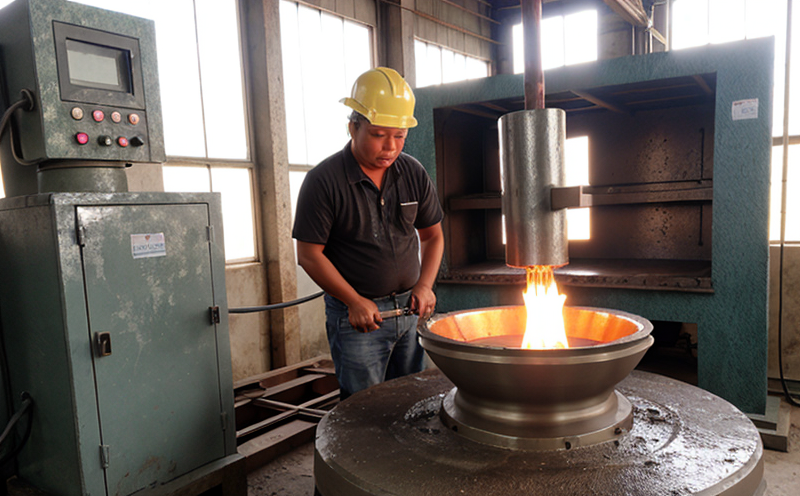ISO 8104 Acoustic Emission Testing of Foundry Products
The ISO 8104 standard provides a comprehensive framework for conducting acoustic emission (AE) testing on foundry products. This method is particularly useful in identifying defects and monitoring the integrity of castings during the manufacturing process. Acoustic emission testing involves detecting, locating, and analyzing sound waves produced by structural changes or failures within materials under stress.
The primary application of ISO 8104 AE testing lies in its ability to detect early signs of material fatigue, cracks, and other defects that can compromise the structural integrity of castings. This non-destructive method is ideal for quality assurance and compliance with international standards such as ISO 8104-2 (which deals specifically with the detection of flaws using acoustic emission).
The process involves placing transducers on the casting to monitor sound emissions. These emissions are then analyzed to determine their source and severity, helping manufacturers identify potential issues before they escalate into major defects. This proactive approach not only enhances product reliability but also reduces costs associated with rework or scrap.
A typical AE test setup includes a variety of components: transducers for detecting the acoustic signals, an amplifier to enhance these signals, and data acquisition systems that capture and analyze the emissions. The testing can be performed on various castings including steel, aluminum, and other alloys used in industrial manufacturing processes.
For quality managers and compliance officers, ISO 8104 AE testing offers a robust method for ensuring product integrity. By identifying defects early in the production process, companies can implement corrective actions before components reach end-users. This not only enhances product reliability but also ensures adherence to international standards like ISO 8104-2.
From an R&D perspective, acoustic emission testing provides valuable insights into material behavior under stress. Engineers can use this data to refine casting processes and improve the overall quality of their products. Additionally, AE testing supports procurement by ensuring that only high-quality materials are used in manufacturing.
In summary, ISO 8104 AE testing is a critical tool for industrial manufacturing and processing, especially within sectors reliant on castings and foundry products. Its ability to detect defects early ensures product reliability and compliance with international standards, while also supporting continuous improvement efforts through detailed data analysis.
Applied Standards
ISO 8104-2 is the primary standard governing acoustic emission testing for foundry products. It outlines the procedures for detecting flaws in castings using this non-destructive technique. The standard specifies the requirements for test equipment, the types of transducers to use, and the criteria for interpreting the results.
Other relevant standards include ISO 8104-3, which covers the testing of large castings where acoustic emission is used in conjunction with other inspection methods. Additionally, EN 12663:2015 provides supplementary guidance on the use of AE technology for quality assurance in foundry processes.
Compliance with these standards ensures that the testing process adheres to international best practices and maintains consistency across different facilities.
Benefits
- Early Defect Detection: Identifies defects early, reducing the risk of catastrophic failures in critical components.
- Non-Destructive: Does not harm or alter the tested material, allowing for repeated testing without compromising product integrity.
- Data-Driven Decisions: Provides detailed insights into material behavior under stress, aiding process optimization and quality improvement.
- Compliance Assurance: Ensures adherence to international standards like ISO 8104-2, enhancing the reputation of manufacturing facilities globally.
- Cost Efficiency: By identifying defects early, companies can avoid costly rework or scrap, thereby improving overall efficiency.
The benefits of ISO 8104 AE testing extend beyond immediate quality assurance. It supports continuous improvement by providing actionable data for process optimization and enhances the reliability of end products, ensuring they meet stringent safety and performance standards.
Eurolab Advantages
EuroLab offers a range of advantages when it comes to ISO 8104 AE testing. Our experienced technicians are trained in the latest testing methodologies and have access to state-of-the-art equipment, ensuring accurate and reliable results.
- Expertise: Our team has extensive experience in conducting acoustic emission tests across various industries, providing tailored solutions for each client's specific needs.
- Accurate Equipment: We use high-quality transducers and data acquisition systems to ensure precise measurements and accurate results.
- Comprehensive Reporting: Our detailed reports provide clear insights into the testing process and any identified defects, enabling informed decision-making by quality managers and compliance officers.
- Supportive Compliance: EuroLab ensures that all tests are conducted in strict adherence to international standards like ISO 8104-2, providing peace of mind for clients seeking full compliance.
We also offer comprehensive training programs to help clients understand the nuances of AE testing and how it can be integrated into their quality assurance processes. This support ensures that our clients are well-equipped to maintain high standards in their manufacturing facilities.





